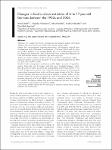Changes in food and nutrient intake of 6- to 17-year-old Germans between the 1980s and 2006
Stahl, Anna
Vohmann, Claudia
Richter, Almut
Heseker, Helmut
Mensink, Gert
Objective: To compare the food consumption and nutrient intakes of German children and adolescents in the 1980s with present dietary habitsDesign: Two cross-sectional representative surveys, the German National Food Consumption Study (Nationale Verzehrsstudie, NVS) from 1985-8 and the nutrition module 'EsKiMo' of the German Health Interview and Examination Survey for Children and Adolescents (KiGGS) from 2006, were analysed for differences in food and nutrient intakes stratified by age and sex groups. Setting: Secondary analyses of data from representative observational studies. Subjects: Children and adolescents aged 6-17 years living in Germany in the 1980s (n 2265) and in 2006 (n 2506). Results: Food consumption was characterised by higher amounts of vegetables/pulses, fruits/nuts and beverages and less meat products/sausages, butter, fats/oils, potatoes/potato products and bread/pastries in 2006 than in 1985-8. The overall changes in food intake were reflected in improvements of macronutrient composition, increased water intake and lower energy density of the diet. Intake of most vitamins and minerals increased in relation to energy intake, but the nutrient density of the diet for vitamins B12 and D decreased. The most critical nutrients observed in NVS and EsKiMo were folate, vitamin D, vitamin A, vitamin E, Ca and Fe. In addition, dietary fibre intake was relatively low and fatty acid and carbohydrate compositions were not favourable. Conclusions: Further efforts will be necessary to improve dietary habits among children and adolescents.
Dateien zu dieser Publikation
Keine Lizenzangabe

